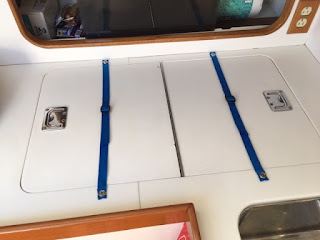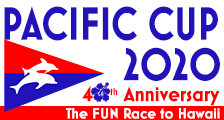Even though we did the race in 2018, there are always things we can do to better prepare the boat for an ocean crossing. While the equipment requirements remain essentially the same for the coming race, a closer read got me thinking about some of the heavy items on the boat. Requirement 1.4 relates to secure storage of heavy items. We had this covered for anchors, batteries, etc. last race but I hadn't looked closely at our ice box lid and the stove. The ice box lid, while hinged in the middle to gain access to the contents, is not physically attached to the ice box/counter and is held in place purely by its weight (which is substantial). If we got rolled the ice box lid, not to mention the contents of the ice box, would become dangerous projectiles. The crew and I spent some time considering a variety of methods to secure the lid. We wanted something that would keep the lid in place, but not make it difficult to access the contents of the ice box or interfere with food preparation counter space (which the top of the ice box lid doubles as when closed). We decided on light weight polypropylene webbing with a plastic adjuster. Each side is screwed into the counter and underlying plywood. Breaking strength of 450 pounds. It's easy to open/close, doesn't absorb water, lays flat on the counter top, and flips out of the way for cleaning or access to the ice box.


The stove required some closer inspection. As it's gimbaled, there's a bracket on each side that the stove rests on. These are stamped stainless steel. Each as a small tab that, when oriented correctly, is supposed to keep the stove from hopping out of the bracket. Turns out the little tab was not oriented properly - now it is.
The stove also has bolts on the front corners that slide into receptacles on each side of the stove that prevents the stove from swinging and would also aid in keeping the stove in place in the event of a roll or knock down. While the bolt on the right side of the stove would set nice and deep, the one on the left only set in its receptacle about 1mm - clearly not much holding power. So I added a 1/4" piece of starboard behind the teak so that the bolt now sets deeply.



All these changes are definitely an improvement on the existing hardware, however, we felt more was needed given the weight of the stove. The biggest concern being that the stove comes up out of the brackets on the side (or down if the boat were inverted). Again, we considered a lot of different approaches looking for something simple, light weight, and easy to install/remove. Our solution was to install a thru-bolted padeye in the back of the stove alcove and then run 3/16" dyneema line from the padeye to the grab bar in front of the stove. When not in use the line can hang behind the stove or be removed. It takes about 15 seconds to install. Should conditions warrant, between the gimbal brackets, the locking bolts on the front, and the dyneema line, we should be able to keep the stove in place.


















